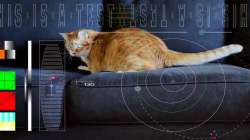NASA beams first-ever cat video from deep space using laser tech | Watch video
NASA made a big leap by sending the first cat video from deep space using laser tech, proving it can improve communication for missions like going to Mars.

In a recent achievement, NASA has successfully transmitted a high-definition cat video from a spaceship positioned 19 million miles away from Earth. This marks the first video streamed from deep space and showcases the potential for higher-data-rate communications crucial for intricate missions like sending humans to Mars.
Meow-vie from Deep Space
The 15-second video features an orange tabby named Taters and was transmitted using a state-of-the-art laser communication system on the Psyche probe. Currently, on a mission to explore a mysterious metal-rich object in the main asteroid belt between Mars and Jupiter, the spaceship was an impressive 80 times the distance between the Earth and the Moon when it beamed the video.
Laser Communication
Traditionally, space missions relied on radio waves for data transmission. However, NASA's recent feat utilised lasers, which can increase data rates by 10 to 100 times. The encoded near-infrared signal was received by the Hale Telescope at Caltech's Palomar Observatory and then sent to NASA's Jet Propulsion Laboratory (JPL) in Southern California.
Ultra-HD Video Transmission
Reportedly, the ultra-HD video took 101 seconds to travel to Earth at a maximum bit rate of 267 megabits per second—faster than most home broadband connections. Despite the vast distance, the laser transmission outpaced the internet connection used to send the video from Palomar to JPL.
Why a Cat Video?
NASA chose a cat video for its historic significance and internet culture relevance. The choice pays homage to the 1920s when a statue of Felix the Cat was broadcast as a test image during the growing interest in television. Cats, known for dominating internet videos and memes, provided a playful touch to this groundbreaking demonstration.
Laser Tech Challenges
Deploying laser transmission in deep space presented significant challenges. The precision required for aiming a laser beam from millions of miles away, accounting for the movement of both the spacecraft and Earth during signal travel time, required sophisticated engineering solutions.
ALSO READ | Is Apple adding a special "Capture Button" to the next iPhone for video recording?
ALSO READ | Why can't Apple sell Watch Series 9 and Ultra 2 in the US anymore? DEETS inside